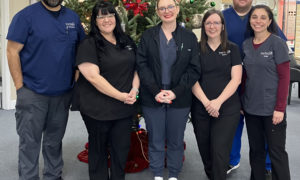By Brian Chou, OD,  FAAO
FAAO
March 9, 2016
According to authors B. Joseph Pine II and James H. Gilmore, it’s no longer enough for business owners to simply offer products and services and expect to thrive. They argue that we are operating today in the experience economy of delivering memorable events by linking emotions and feelings to our products and services. Disney is an oft-cited example of a business that does well in this new economy.
Orchestrating desirable patient experiences requires a physical space that’s conducive, but the people within the practice arguably play a greater role. From the many practices that I’ve visited, to my own, I’ve observed that the primary determinant of the patient experience is how the staff and doctors communicate with the patient. Too often, our staff communicates a “glass half empty” proposition to our patients, unwittingly leaving a lingering pessimism. Take, for example, the following four scenarios.
Staff makes an appointment reminder phone call
Negative Nancy: “I’m reminding you of your appointment with Dr. Smith tomorrow at 9 a.m. If you need to cancel or reschedule your appointment, please call 867-5309.”
Polly Positive: “All of us at Dr. Smith’s office look forward to your reserved time with us tomorrow at 9 a.m. Our number is 867-5309 in case we can be of service.”
Optician reviews vision plan coverage
Optician reviews vision plan for a patient who needs new glasses, but with a vision plan that hasn’t renewed for full frame and lens eligibility.
Negative Nancy: “Unfortunately, you are not eligible for new eyeglass frames or lenses for another 10 months.”
Polly Positive: “This year your vision plan provides you a 20 percent savings off your new pair of glasses.”
Patient who hasn’t had an eye exam in three years
Patient who hasn’t had an eye exam in three years is on the phone with staff requesting a valid contact lens extension because she hasn’t noticed any changes.
Negative Nancy: “No, you can’t get a new prescription. You have to schedule a new exam because you are way past due.”
Polly Positive: “Yes, we’d gladly update your contact lens prescription. I’ll need to schedule you for a new contact lens exam, so the doctor can ensure your eyes are free of asymptomatic disease, and confirm there are no subtle changes in vision, as you suspect.”
Patient inquires with optician about Transitions Signature VII lenses
Negative Nancy: “Transitions lenses do not darken well in the car because the windshield filters out the ultraviolet light required to activate them.”
Polly Positive: “Transitions lenses are great everyday lenses, which adjust from clear indoors to dark outdoors.”
While it’s easy to believe the naysayers are among our staff, our own verbiage and actions carry bad vibes probably just as often. This was something I realized during my fellowship in refractive surgery management. Many of the ODs I observed providing post-operative LASIK care gravitated to asking, “Are you having any problems?” This negative leading question trained patients to look for problems. I, too, was guilty of doing this, probably because our scope-of-care expansion into eye disease puts us in the frame of mind of managing eye sickness and pain.
It’s better to link positive emotion to what just happened by asking, “How are you enjoying your life following LASIK?” On post-op day one, rather than measuring visual acuity by presenting the threshold letters (e.g. 20/20 letters) to reach the endpoint quickly, there is value to the patient’s psychological well-being to start with the pre-op uncorrected visual acuity (e.g. 20/400 letters) and then work downward. Doing so reinforces progress rather than casting doubt on the outcome.
The same strategy works well for corneal refractive therapy and contact lens prescribing. Ask patients questions like, “What do you notice you can do now that you couldn’t do before?” instead of asking, “Are you having trouble seeing anything?” Finally, schedule the patients to return for a “progress visit” rather than calling it a “follow-up.”
Positive emotional contagion creates favorable patient experiences. Both staff and doctors are responsible for shaping this outcome by communicating what they can do, instead of what they cannot, and demonstrating warmth, concern and compassion, all while maintaining a “glass half full” attitude.
How do you set a positive tone in your office? What training do you give staff about staying positive when communicating with patients?
Brian Chou, OD, FAAO, is a partner with EyeLux Optometry in San Diego, Calif. To contact him: chou@refractivesource.com.



























